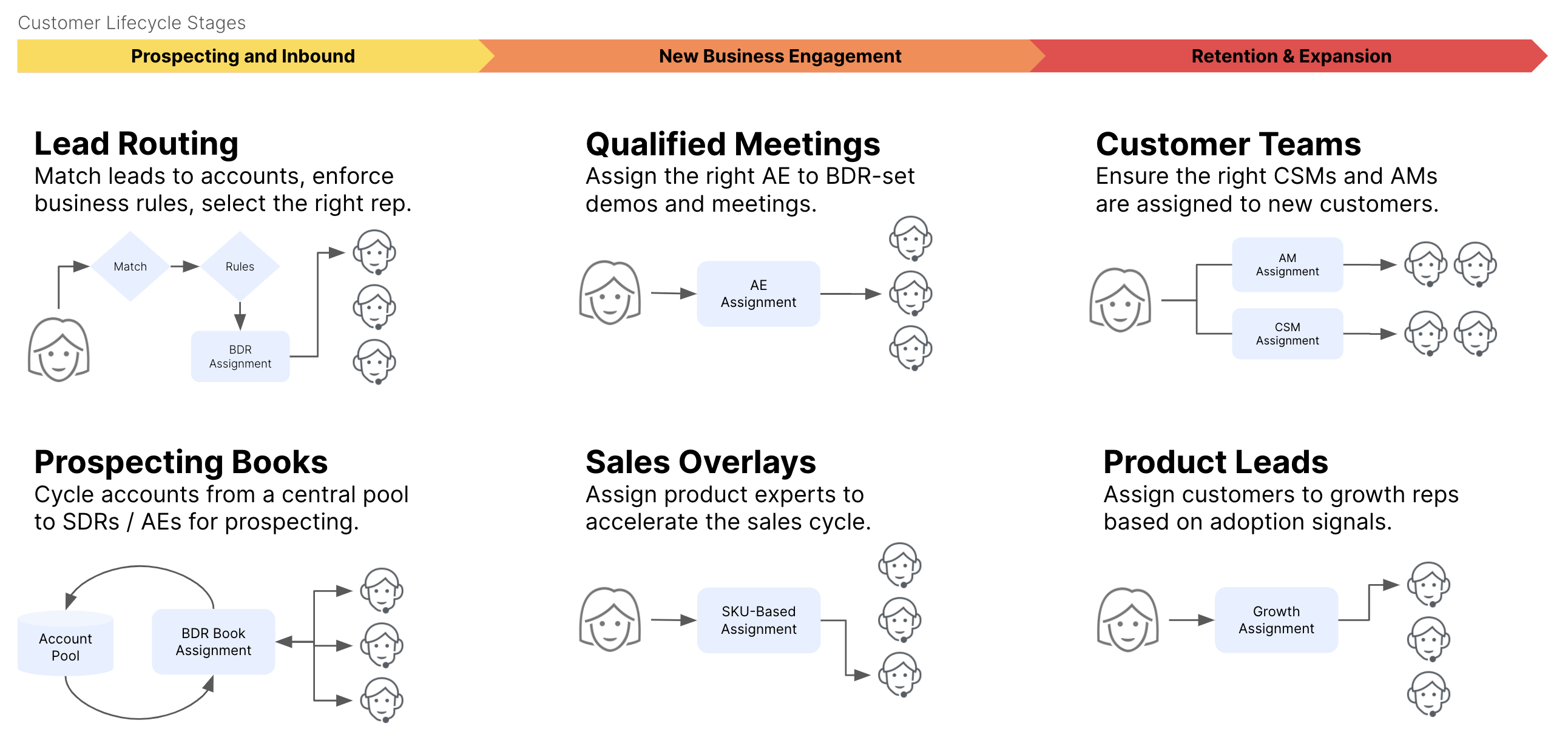In my role as a Revenue Operations leader and especially since founding Gradient Works (all of 3 months ago!), I’ve had tons of conversations with revenue leaders and operators at all stages - from tiny startups to multi-billion dollar public companies. One topic that consistently comes up is sales rep assignment - making sure that you’ve got the right kind of reps assigned to the right accounts/opportunities/leads at the right stage. It’s a tricky thing that most high-velocity B2B revenue organizations struggle with.
I think of revenue organizations as a factory. Our goal is to create a system that converts raw materials (prospects) into a finished product (retained, revenue-generating customers) as quickly and efficiently as possible. To continue the metaphor a little further, modern revenue orgs often operate like an assembly line; prospects move in stages from one specialized team to the next, getting increasingly “finished” along the way.
Now, you don’t actually assign a prospect or customer to a team. You actually assign it to a person: an individual human BDR, AE, AM, CSM or any of the other acronyms for the increasingly specialized roles we have on our revenue teams. This is where the factory metaphor gets a little more foggy. Each individual is different, and while they each follow the same process (hopefully!), it’s their unique skills that ultimately drives the outcome at each stage.
This means that assignment is one of the core jobs of any revenue leader. It’s your job to decide who should be responsible for any given prospect or customer at any given stage in the sales process. This ultimately sits at the core of org structure, capacity planning, goal setting and pretty much everything else you have to do as a revenue leader.
Let’s explore a little bit about how this works tactically.
What, who, when?
We typically start thinking about assignments in terms of territories and customer segmentation. (I leave territory and segment design for a future post.) When your team is small, individual territories and segments are usually synonymous with an individual: e.g. “every lead that comes from New York is going to go to Sam because she owns the Northeast” or “this customer goes to Anil because he handles enterprise accounts with more than $100k ACV”. As you scale, you typically move beyond one territory or segment owner to a team of reps responsible for a particular segment. This leads to a new problem: once you’ve figured out a segment, which sales rep should get a given assignment?
That’s easy, you say… we’ll just hand them out equally, round robin style. This is a good start, but in practice it gets hairy quickly. What about the rep that hoards opps and has way more accounts in their name than everyone else? What about the rep that was on vacation and lost a week of assignments? What about the rep that’s just not performing who just got assigned the best lead to come in in ages? In my experience, everyone’s “simple round robin” usually becomes a weighted round robin (to give some people more turns in the queue) with some kind of manual order adjustment (to give a rep “another turn” or the “next slot”) and some level of capacity balancing (to not overload any given rep). These advanced round robin techniques can get pretty complicated!
Automation in the front, spreadsheets in the back
These challenges result in a pattern I’ve seen play out at many organizations. Because of the nature of a typical sales funnel, there are fewer assignments to perform at each stage (e.g. there are going to be more leads than there will be opportunities qualified by a BDR). However, each of those assignments is typically more valuable because it represents an opportunity that’s farther along in the funnel (“closer to finished” in our factory analogy). This inversion of volume and value means organizations typically implement automations at the top of the funnel and then rely on manual assignment later in the funnel because they feel like it’s “safer”. Let’s call it “Automation in the Front, Spreadsheets in the Back”.
While understandable, I think this approach has big drawbacks.
First, it means that assignment processes are inconsistent. Automation forces you to clearly specify your rules while a manual process allows significantly more human error (or “judgement calls”) to enter into the process which will produce varying results.
Second, you typically give up data integrity and audit capabilities in the manual process. Looking up “who’s next” in a report or a spreadsheet and then flipping their ownership in Salesforce means you don’t have a single source of truth for what exactly happened when. That makes it hard to answer the inevitable question about why one sales rep got an assignment and another didn’t.
Finally, manual processes don’t scale. If you don’t plan to increase the volume of deals in your funnel, then don’t worry about this one. If you’re in the process of scaling now, you should really be thinking about how that manual spreadsheet is going to work when you have 2x the number of SAOs being assigned by 2x the number of BDRS to 2x the number of AEs, or 3x the number of customers to 2x the onboarding sales reps and so on.
What now?
So with all these issues, what should an organization do?
- Think holistically - Don’t just think about lead routing, setting demo appointments for AEs, etc in silos. They’re all instances of the same basic problem. Try to solve them in similar ways. One specific situation that causes problems is doing lead routing in your Marketing Automation platform and all other assignments in your CRM. I recommend implementing all of it in CRM - this at least keeps your logic in one place.
- Maintain an audit trail - You’re 100% guaranteed to have times where you need to explain why a particular assignment was made and to review the chain of ownership of a particular item. Make sure that whatever you do, you maintain an audit trail. If you use Salesforce, at a minimum you should turn field history tracking on for assignment-related fields.
- Automate - Even if it’s easy to use a spreadsheet now, it’ll lead to inconsistencies now and it’ll get harder in the future. Salesforce offers great tools like Flow to help you automate all kinds of tasks. This forces you to be explicit about your rules and helps drive consistent results.
- Learn from others - While “round robin assignment” eventually turns into something more complex, you can get started with a basic version fairly easily. If you’re using Salesforce, we've got an overview all the ways to actually implement round robin assignment in Salesforce.
We’ll have a lot more to say on this topic in the future. If you liked this and want weekly updates with content to help you run your revenue organization, sign up for our newsletter.





